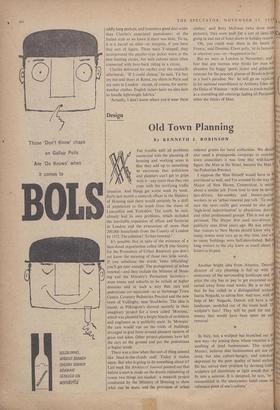Design
Old Town Planning
By KENNETH J. ROBINSON
rim trouble with all problems connected with the planning of housing and working areas is that they add up to something so enormous that politicians and planners can't get to grips with it—any more than they can cope with the terrifying traffic situation. And things get worse week by week. Early last month a research officer in the Ministry of Housing said there would certainly be a drift of population to the south from the slums of Lancashire and Yorkshire. The south, he said, already had its own problems, which included the inevitable expansion of offices and factories in London and the evacuation of more than 200,000 households from the County of London by 1972. The solution? 'Urban renewal.'
It's possible that in spite of the existence of a ham-fisted organisation called SPUR (the Society for the Promotion of Urban Renewal) you don't yet know the meaning of those two little words. If you substitute the words 'town rebuilding' you'll get near enough. The protagonists of urban renewal—and they include the Minister of Hous- ing and the Ministry's Permanent Secretary— want towns and suburbs to be rebuilt at higher densities and in such a way that cars and pedestrians are separated—as at Stevenage Town Centre, Coventry Pedestrian Precinct and the new town of Vallingby, near Stockholm. The idea is sound, as Pilkington's showed recently in their imaginary project for a town called `Motopia,' which was planned by a bright bunch of architects and engineers as a publicity stunt. In `Motopia' the cars would run on the roofs of buildings arranged in grid form around pleasant squares of grass and lakes. Other project-planners have left the cars on the ground and put the pedestrians at higher levels.
There was a time when this sort of thing seemed like head-in-the-clouds stuff. Today it makes sense. But who is going to do something about it? Last week the Ar'chitects' Journal pointed out that before a start is made on the drastic replanning of towns two things are needed : a research project conducted by the Ministry, of Housing to show what can be done, and the provision of urban
renewal grants for local authorities. We should also need a propaganda campaign to convine town councillors it was time that well-known figure, the Man in the Street, became the Man irl the Pedestrian Precinct.
I suppose the Man himself would have to be convinced as well, and I'm amused by the way t Ile Mayor of New Haven, Connecticut, is settintI about a similar job. From time to time he invit0 taxi-drivers, bar-tenders and beauty-parloor workers to an 'urban renewal pep talk.' To mat' sure the news really gets around he also givel 'high-level indoctrination' to physicians, dentiO and other professional groups. This is not an ev periment. The Mayor first used taxi-drivers II' publicity men three years ago. He was anxioti that visitors to New Haven should know why se many streets were torn up at that time;and wli so many buildings were half-demolished. Befor long visitors to the city knew as much about future as its past.
Another bright idea from America. Detroit director of city planning is fed up with Ole monotony of the surrounding landscape and 014 price the city has to pay to get excavated eld carted away from road works. He is so fed a that he has called in a distinguished sculptor' Isama Nogachi, to advise him. And now, with IV help of Mr. Nogachi, Detroit will have a Iwo landscape, modelled out of the waste land. -III sculptor's fees? They will be paid for out or money that would have been spent on eall removal.
In Italy, too, a sculptor has branched out in new way—by joining those whose vocation is soothing of tired businessmen. This sculptor Munari, believes that businessmen are not on' tired, but also culture-hungry, and COCIStailll depressed by the poor quality of hotel etchinc' He has solved their problem by devising fold0 sculpture (of aluminium or light wood) that fit into a suitcase. It is designed, he says, 'to I` reassembled in the anonymous hotel room as reference point of one's culture.'
tut ,•
115 be ();•1
ILL et), CO, iii
re■ nee be in.,'
Lb Oik "1) ii rQ%.
IL Q111
'I) ()I) I tile










































 Previous page
Previous page